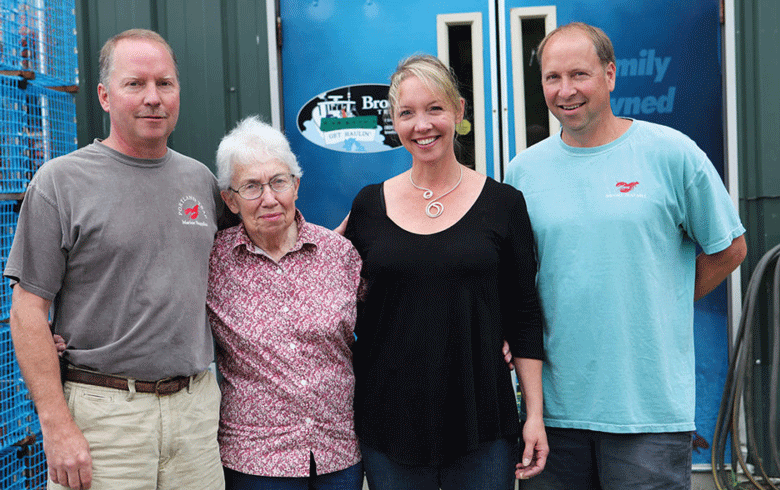You see the signs everywhere: “Help Wanted” or “Hiring Now.” Businesses in every sector of Maine’s economy have found it difficult to hire the number and type of workers they need. The problem has become acute in the businesses that supply lobstermen with their traps and other equipment.
“Sadly, we’ve been calling customers to ask if they could live without new traps,” said Stephen Brooks, co-owner of Brooks Trap Mill in Thomaston. “We told them they could get them later or next year. Many cancelled their orders. I’ve been in this business all my life and I have never experienced anything like this struggle to get workers.”
The labor issue also is affecting marine businesses outside of Maine. Riverdale Mills, a wire mesh manufacturer in Northridge, Mass., currently is advertising for everything from a forklift driver to a welding machine operator to keep its three shifts in production. The company is even offering new hourly employees a $700 hiring bonus.
“Our production level is half or less than half of what it was last year.”
—Stephen Brooks
“We’ve reached out to get workers back,” Brooks added, “but some have just disappeared. Our production level is half or less than half of what it was last year.”
Maine’s Department of Labor established a “back to work” grant program which provided companies with funds to give bonuses to newly hired full-time and part-time workers. A full-time worker could receive $1,500 if he or she took a job and stopped receiving unemployment benefits for two months or more.
By late July, 100 companies had applied for grants to entice approximately 300 workers to fill empty positions, according to the Department of Labor.
Of course, much of the economic disruption is linked to the pandemic.
“We stayed busy last year and were OK at the beginning of this year but things just kept getting worse,” Brooks explained. “Most lobstermen place their orders at the end of the year for next year. We had the orders and everything all scheduled out but then we started losing people. And it just never stopped.”
Many point to the extra $300 in federal unemployment benefits that began in December as the culprit in the current labor shortage. That amount, combined with state unemployment benefits, is thought to motivate people to remain unemployed because the total in benefits is greater than what they would receive once employed.
“Maine’s prime working-age population … peaked at just under 745,000 in 2006…”
—James Myall
Others see a more complex cause for the acute labor shortage. James Myall at the Maine Center for Economic Policy at the University of Maine noted in a recent paper that Maine has long had a shortage of workers.
“Maine’s prime working-age population—25-64-year-olds—peaked at just under 745,000 in 2006. Since then, that number has steadily declined to just over 703,000 in 2019,” Myall wrote.
Those who lost their jobs may face new obstacles to getting back to work, among them childcare. According to the Maine Department of Health and Human Services, approximately 100 childcare facilities closed during the pandemic, and the rest operated at reduced capacities.
Brooks, like many other business owners, has a limited number of options available to entice employees.
“We try to have competitive wages for our employees plus health benefits which are equivalent to $3 per hour. Then there are bonuses and vacation time and holidays. If we raised wages for some, then we would have to raise them for all to be fair. But we don’t know how long we could sustain that. What happens in the long term?” he said.
Currently the company pays each worker who comes to work as scheduled all week an extra dollar per hour for that week.
The Department of Labor estimates that as of June, the state had 25,100 fewer jobs than before the pandemic began. Yet the labor participation rate in the state remains low.
The labor participation rate is the percentage of the population that is either working or actively looking for work. In February 2020, that rate was 62.6 percent of the state’s population. In February of this year, that figure had dropped to 59.9 percent, rising to 60.2 percent by June. One of the reasons that the labor participation rate in the state is relatively low compared to other states is that so many in Maine’s population are over 65 years old. Older Maine residents are less likely than younger ones to be in the labor force.
Brooks is not only concerned about finding workers, he also worries about the rising cost for the materials he uses in his business.
“Everything we sell has increased in price at least once, sometimes up to five times. Literally everything in our traps costs more,” he said. A recent shipment of wire imported from overseas came with a whopping surprise: a $12,000 freight cost on top of the normal $5,000 fee. Some other containers which used to cost $5,000 for delivery are now $25,000 to $28,000 for freight.
“It doesn’t matter where it comes from, whether its buoys out of Texas or wire from Italy,” Brooks said. “Our shipping costs are up to five times more than they were in the past, and some items aren’t even being shipped.”
Maine will ended the extended federal unemployment benefits on Sept. 6. For Brooks, getting through the rest of the year without losing more customers is his primary worry.
“We’re going to hunker down and work through it. It is a scary time,” he said.
This story first appeared in Landings, the publication of the Maine Lobstermen’s Alliance, and is reprinted by permission.





